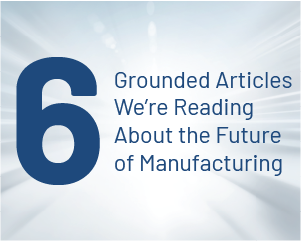One of the most important qualities to have when reading about the future of manufacturing is skepticism. Even technical articles often get lost in the overly optimistic or the dystopian, leading to a lot of excitement but little room for pragmatism. That’s why we organized a list of grounded, reasonable articles that we’re reading about the future of manufacturing. By delving into recent analyses and reports from trusted sources, we want to provide a balanced view that acknowledges both the potential and the pitfalls of the road ahead. As we explore a variety of topics including digital innovations, policy impacts, evolving landscape of quality control, and workforce development, our goal is to offer insights that are both pragmatic and forward-looking.
1- Deloitte 2024 Manufacturing Industry Outlook
The Bottom Line: Digital innovations offer some real benefits to manufacturing, but supply chain challenges will still be an issue.
In this comprehensive report, Deloitte breaks down the major potential changes coming to manufacturing this year including opportunities to improve talent acquisition, agility and resilience improvements, and more. As federal funding and incentives drive net zero initiatives and more electronics related manufacturing, the future of manufacturing is much more dynamic and energized than before. This report isn’t all positive however. Supply chain problems and workforce retention are still significant concerns in 2024, and can stymie progress if left unchecked. But overall, the Manufacturing Industry Outlook by Deloitte presents a pragmatic and optimistic analysis of this year.
2- The IRA and CHIPS Act are supercharging US manufacturing construction
The Bottom Line: Investments spurred by the CHIPS Act are transforming US manufacturing.
A full year after the passage of the CHIPS Act, reporting by the Atlantic Council has found significant improvements to the development of new manufacturing in the US. Specifically, it analyzes total spending in manufacturing construction and measures the increase against the last decade and international benchmarks. Its findings are extraordinary. While it will take years for the effects to be felt across the US manufacturing industry, the investments into new computing will have a monumental impact on US manufacturing in the 21st century.
3- How 5G is Reshaping the Future of Manufacturing
The Bottom Line: Even a 6 year old technology (5G) still has a lot of value for manufacturing
One of the biggest hurdles to a fully integrated digital backend for a manufacturing system is having the internet framework to support it. This article breaks down how 5G technology is affecting the manufacturing industry by enabling seamless collaboration and interconnected environments through its integration with IoT, AI, edge computing, and AR/VR. It highlights 5G’s advantages, including extremely low latency for real-time communication, high data transfer rates for handling large volumes of data, and the capability to support numerous device connections, enhancing automation and operational efficiency. Additionally, 5G’s reliability and network slicing cater to the specific needs of automation applications, while its enhanced mobile broadband (eMBB) capability supports demanding AR/VR applications. The use of 5G facilitates improved decision-making, efficiency, and competitiveness, transforming manufacturing operations and supply chain management through advanced connectivity and technological applications.
4- Frustrated By the Constant Hype Around New Tech in Manufacturing?
The Bottom Line: Many tech promises are overblown, but we can take a measured approach.
With a refreshing contrast to other idealistic opinions about the future, this article addresses the issue of technology hype in manufacturing, particularly around emerging technologies like 3D printing and AI. It acknowledges the skepticism caused by overblown claims but argues that, beyond the hype, technologies like 3D printing have found valuable applications in the industry. The best way to implement these technologies is not to endlessly hype them, but to conduct rigorous evaluations that identify where these technologies can genuinely enhance their operations. Despite initial over-expectations, the article suggests that there is real potential for these technologies to improve manufacturing processes, urging professionals to reconsider their stance and explore practical applications.
5- The Future of Quality Control in Manufacturing Facilities
The Bottom Line: Big data and IoT significantly enhance manufacturing quality control, leading to improved product quality, efficiency, and reduced costs.
Unlike most content that discusses recent technology, this article hones in on the grounded ways that Quality Control operations can benefit from innovation. Big data and IoT technologies in manufacturing quality control offer a chance to enhance defect detection, predictive analytics, and resource optimization. Big data analytics facilitates the identification of patterns and anomalies for real-time error correction, predictive maintenance to avert failures, and effective resource allocation, thereby improving product quality and supply chain management. IoT technologies revolutionize quality control further by enabling remote monitoring, automated inspections, and data-driven decision-making, ensuring higher product quality, reduced costs, and increased efficiency. These advancements promise manufacturers a competitive edge not 10 years from now, but today. Through improved processes, customer satisfaction, and adherence to industry standards, these innovations can catalyze a shift towards a more efficient, quality-focused manufacturing landscape.
6- Navigating the Next Frontier: US Manufacturing and Industry Being Shaped by Technology Adoption
The Bottom Line: US manufacturing stands at a crossroads: challenged by a skills gap, yet poised for growth through innovation and global demand.
This article explores the pivotal moment facing the US manufacturing sector, namely the opportunities of an increased global appetite for advanced manufactured goods and the challenges of using technology to meet the demand. It outlines significant challenges, such as the skills gap—with 2.1 million manufacturing positions potentially unfilled by 2030 due to a lack of trained workers in advanced roles—and the US’s lagging position in R&D investment, ranking 12th among developed nations. Despite these hurdles, there are still promising opportunities, including a global demand surge for advanced manufactured goods and a growing imperative for sustainability, suggesting that innovation and adaptation could secure the US’s leadership in the manufacturing domain.


